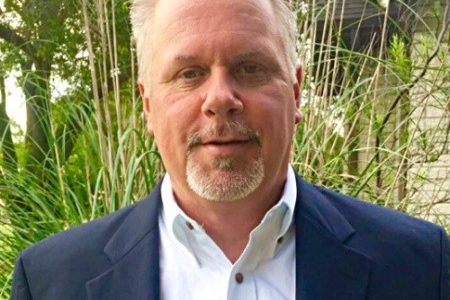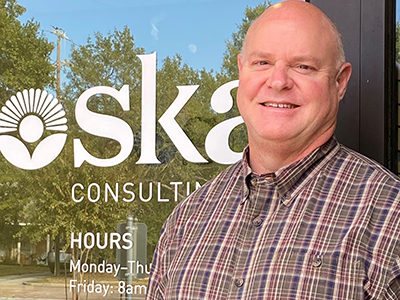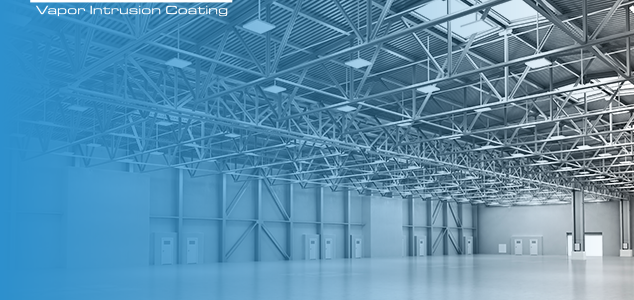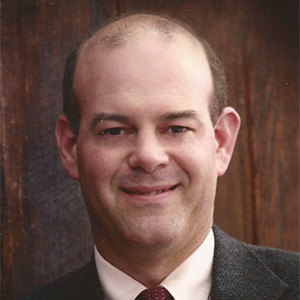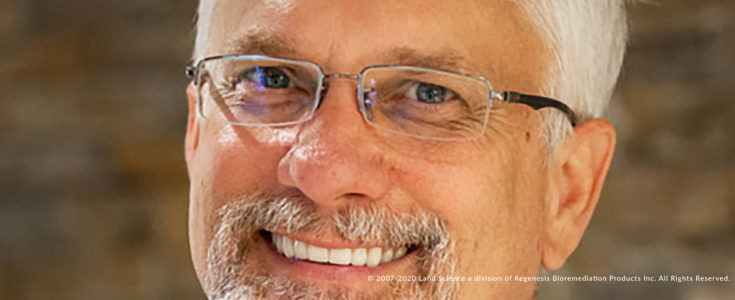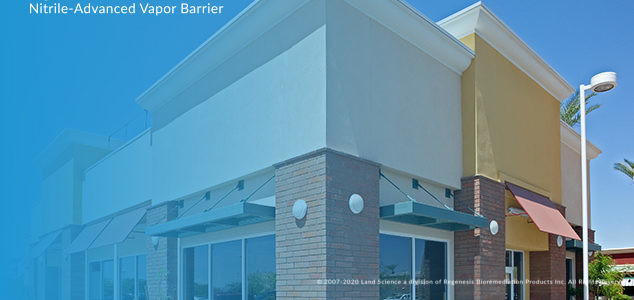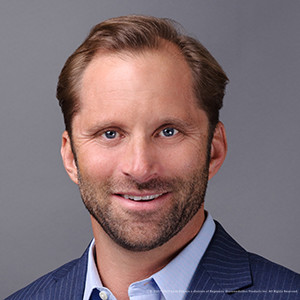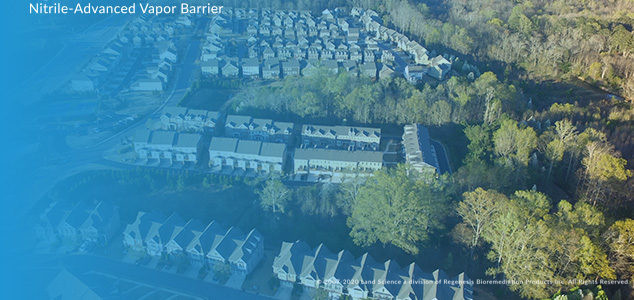TerraShield Installed at New, State-of-the-Art Aquatic Research and Education Center
Project snapshot highlights:
- Volatile Organic Contaminants
- State-of-the-Art Research and Education Center
- 8,500 Square Feet Installed
In Michigan’s Upper Peninsula, Lake Superior State University (LSSU) is constructing a $14.5 million expansion that will house its state-of-the-art Center for Freshwater Research and Education (CFRE). When completed, the CFRE building will include freshwater testing laboratories, classrooms, an aquatic learning center, and an expansion of LSSU’s internationally-renowned fish hatchery. The new building is being constructed in an area of past spills of volatile organic contaminants (VOCs), posing a potential vapor intrusion risk. Assessing the risk and the options to mitigate it, the project team opted to install TerraShield® with a TerraVent® passive venting system. Terrashield was determined to be the vapor mitigation solution providing the highest level of protection at a competitive cost and offering superior installation efficiencies as compared to alternative vapor intrusion mitigation approaches.
Client Spotlight: Brad Parish, P.G., Senior Hydrogeologist with Apex Companies LLC
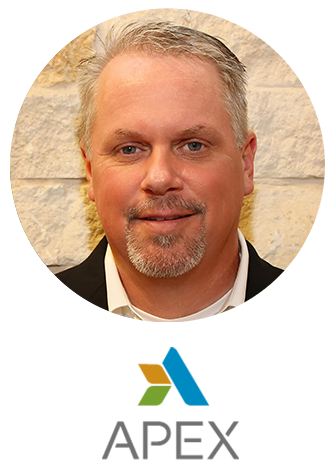
If you ask Brad Parish, P.G., Senior Hydrogeologist with Apex Companies LLC, an award-winning water environmental services firm, what he enjoys most about his work, you’ll likely hear it’s the opportunity to distill his nearly 30 years of experience in groundwater hydraulics and contaminant plume movement into simplified solutions for his clients. He begins, “The best part of my job is that I have the opportunity to assist clients with sound science. Most of our clients are focused on their day-to-day business and they don’t have time to truly understand everything we do. Therefore, we must instill trust in our clients that we have provided the most technically feasible solution to their needs at the most effective long-term cost scenario.” Providing not only tech-based, feasible solutions, but also successful outcomes has been a hallmark of Parish’s work throughout his 19 years with Apex, a valued REGENESIS® and Land Science® client. In his current role, he manages projects involving subsurface characterization, contaminant transport and occurrence, development of site conceptual models, and development of plume remedies. He continues, “Essentially, I enjoy the science of geology and its application to groundwater hydraulics and contaminant plume movement.” Hired initially as a Senior Project Manager in 2002, Parish managed large-scale technical projects, before expanding his role into other related areas. “On many projects,” he says, “I am essentially a technical resource as a Senior Hydrogeologist, and I have also acted as an office manager for Geoscience Groups.”
Prior to joining Apex, Parish held Hydrogeologist positions at several other firms, after earning his BS in Geology from Tarleton State University and Master of Science degree in Geology, from Baylor University in 1992. It was during his master’s program at Baylor that he became interested in a career in hydrogeology. He continues, “At Baylor, I became drawn to the various geomorphic processes and how those processes were affected by subsurface geologic structure and surface lithology. Advanced level courses in hydrogeology really lifted my interest in subsurface fluid dynamics. The next step involved learning geochemistry and how chemicals in groundwater affect or are affected by groundwater flow.” The selection of Baylor for his graduate studies proved invaluable, since at the time, the program provided its own drilling rig. “This afforded me the opportunity to learn well installation, soil and groundwater sampling, and logging techniques while in graduate school- an experience few other programs could match. Overall, my graduate studies really helped solidify my future career path because, in my opinion, understanding subsurface geology and developing an accurate conceptual site model are the most critical in the development of a successful remedy for any site with groundwater contamination.” To stay abreast of trends in his field and new technology, Parish
spends 2-4 hours a month in continuing education. In addition, he participates in several ITRC training modules and webinars that focus on enhanced MNA topics, and studies current vapor intrusion trends and the ever-changing regulatory framework.
When it comes to working with Land Science, Parish is most impressed with the company’s involvement on product selection based on an array of project needs and budget parameters. He shares an example, “On a recent project, I asked Land Science to develop a repair sequence for a large vapor barrier and passive venting system that was fairly unique. Not only did they provide recommendations for a proper repair sequence, they actually developed the sequence for inclusion in our design for permitting by the local authority. This solution presented significant savings to our client, and we were able to receive approval for the repairs and keep the project on schedule.” In terms of Land Science product usage, Parish states that Apex mainly uses the company’s various vapor barrier products on pre-construction projects, but have also used Retro-Coat® on projects with indoor air quality issues in existing buildings. He shares, “In comparison with other vapor barrier products, Land Science’s suite of vapor barrier systems are typically a less expensive and more technically feasible product. It is also helpful that Land Science provides a list of certified installers for their products, and my experience with their installers has been very positive.”
When asked about Apex’s future goals, Parish is quick to respond by emphasizing the company’s commitment to innovation and client service. “At Apex, our goal is to consistently team with clients to assist them through their environmental challenges. We also strive to provide feasible strategies and to keep safety at the forefront of our business. We have distinct future growth strategies that we believe enhance our core business offerings. My personal goal is to always listen to a client first; they will always give subtle clues as to how much they understand about what technical scenario or proposal is being provided, along with the financial reserve they have allotted for environmental issues. I always strive to ensure that they understand where their reserve is being spent and the technical reasons why. Only then can we move forward as a team and make strategic decisions that keeps the project on the right path. ”
Residing in the Dallas/Fort Worth area with his wife of 30 years, Parish has developed a keen awareness and fondness for Texas, since nearly all of his project work over the years has been located within the Lone Star state. He also enjoys a variety of hobbies outside of his work responsibilities. He shares, “Fortunately for me and my wife, who is also a geologist, most of our vacations center around some geologic concept or area. We’ve spent a lot of time in the Big Bend and Hill Country areas of Texas, the coastal regions of North Carolina, and the various Rocky Mountain states. Golf is also a favorite hobby for me and my family.” As one might expect from someone who has worked in the same industry for nearly three decades, Parish has observed an array of changes, although as he points out, some aspects of his work haven’t changed much. He continues, “I believe industry services have changed based on culture. Today, there is a lot more focus on Industrial Hygiene and Safety Compliance. For me, I am still looking at grain size analysis of soil cores- just like I did back in the early 1990’s!” And the most demanding part of his job? “Juggling the amount of time available to assist all clients, regardless of the size or budget of the project.” When it comes to encouraging others to join his field of study, he suggests that one should start with the basics. He concludes, “I would challenge every college student to take a Physical Geology freshman class. I was an engineering student as a freshman and decided to take Physical Geology as a science credit…and I’ve been hooked ever since!”
Land Science is proud to have Brad Parish, P.G., Senior Hydrogeologist with Apex Companies LLC, as a valued client and partner in environmental remediation, and appreciates his highly specialized background and commitment in providing successful remediation and mitigation outcomes for Land Science and its clients.
Client Spotlight: Mike Schultz, Principal Engineer with SKA Consulting, L.P.
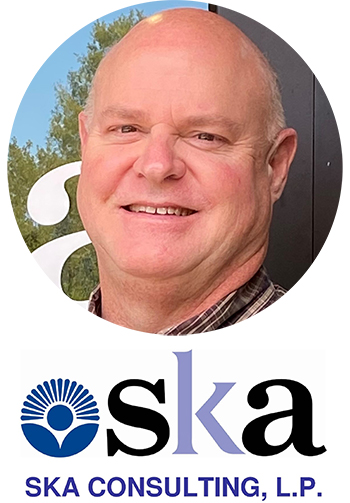
For Mike Schultz, P.E., Partner and Principal Engineer with SKA Consulting, L.P., a leading environmental engineering and consulting firm, having a diverse role with various responsibilities is both challenging and highly fulfilling. From overseeing technical aspects of an array of projects, to client management and new business development, Schultz is involved in nearly every aspect of SKA’s business – and he wouldn’t have it any other way. He begins, “As a Principal and Partner in the firm, I get to wear many hats. On the project side, my responsibilities include technical oversight of assessment, design, and installation projects. I’m also involved with project financial management, as well as business development and proposal writing for new work.” With a 16-year track record of success with SKA and an environmental remediation career that spans more than 30 years, Schultz continues to be driven by the gratification that comes from seeing first-hand how effective teamwork and environmental technology can work together to provide positive impacts on our environment. He continues, “As a firm, SKA brings together environmental and regulatory strategies to achieve unique solutions for our clients. We want to be part of solving problems in a client’s plan for a project. It’s gratifying to drive through town and see a new apartment complex or a retail center and know that before we became involved with that project, the site was a dilapidated former industrial facility or an abandoned railyard. We were part of the client’s solution for that property.”
Before joining SKA in 2004, Schultz served as a staff engineer, project manager, and an office operations manager at other environmental engineering firms, after earning his BS in Mining Engineering from the Colorado School of Mines. He spent the first two years of his career involved in environmental permitting studies for surface mining operations as a member of the Surface Mining and Reclamation Division of the Railroad Commission of Texas. He then joined Hall Southwest Corporation in Austin, Texas as a private consultant, conducting baseline geology and hydrology studies for proposed and existing mining operations. Schultz continues, “I fell into environmental remediation as the industry developed. When I graduated from college in the mid-1980s, there were no jobs in the US mining industry, so I took the regulatory position with the Railroad Commission because that agency regulated coal and uranium mining in Texas. Then in 1994, Hall Southwest was acquired by Groundwater Technology, Inc. (GTI), a national consulting firm, and I moved from Austin to Houston to manage a GTI office. The rest, as they say…is history.”
When it comes to working with Land Science®, Schultz values the high degree of professionalism, product knowledge, and responsiveness they provide. “Land Science is unique in that, with any project, there are always questions about the product or the application from the owners or other engineers and consultants. When I call Land Science, I get case studies, lab studies, quantifiable data, experiences, supporting products, and trained installation contractors. From my experience, Land Science is not just selling a product- they are partnering with owners and consultants to provide solutions.” Concerning Land Science products, MonoShield® vapor barriers are often used due to cost savings and reduced risk on the affected sites. When asked what he enjoys most about his work, Schultz points to two aspects in particular. “There are two parts of my job that I find very rewarding. The first is when we know we have been a part of helping a client achieve their goals for a project, and second, I enjoy mentoring junior staff and seeing them learn and develop.”
Schultz lives in the Houston area with his wife of 33 years and works out of SKA’s headquarters. Outside of work, he enjoys volunteering with the Boy Scouts of America (BSA), working with youth, and leading them on various camping trips. He shares, “I have been an adult leader in the BSA for about 20 years, starting as a den leader when my sons were in Cub Scouts and serving as a Scoutmaster and a Venturing Crew Advisor. I have had the opportunity to take Scouts camping and backpacking all over the country and in 2016 we took a group of Scouts to Switzerland. My children are now grown, but I continue to volunteer as a merit badge counselor, a shooting sports instructor, a volunteer leader with underprivileged Scouts, and on our council’s International Scouting committee.”
When asked about the most demanding part of his job, he feels identifying the right candidates for the SKA team can be challenging. He continues, “To be a successful consultant, you must be inquisitive, always asking the ‘what, where, when, how, and why’ questions. To solve our clients’ problems, we need to ask those questions to better understand the situation and develop appropriate solutions. We must also stay focused on economically feasible solutions, and not every environmental professional has that kind of focus.” When asked whether he would encourage others to join the environmental field, he suggests they begin with a thorough understanding of environmental science and concludes, “I definitely would encourage young people to study environmental engineering and science. There are many facets to the environmental field, and it is a growing industry. When I came into the environmental industry, no one had heard of greenhouse gases and climate change. Now those are terms that every layman knows.”
Land Science is proud to have Mike Schultz, P.E., Principal Engineer with SKA Consulting, L.P., as a valued client and partner in environmental remediation, and appreciates his deep and diversified experience and commitment in providing successful remediation and mitigation outcomes for Land Science and its clients.
A Growing Manufacturing Company Brings New Jobs to Lansing Area following Retro-Coat Treatment
Project snapshot highlights:
- Retro-Coat Allows Repurposed Industrial Building to Create Jobs in Michigan Community
- 140,000 Square Feet Manufacturing Facility Successfully Treated
A growing manufacturer looking to expand its operations purchased a vacant industrial facility in Lansing, Michigan, where chlorinated solvents were used and spilled into the subsurface. The environmental consultant was asked to address the suspected vapor intrusion concerns resulting from the former industrial operations. In working with the Michigan Department of Environment, Great Lakes & Energy (EGLE), the consultant proposed utilizing the Retro-Coat® Vapor Intrusion Coating System, in combination with passive venting, to ensure safe indoor air for the future workers. EGLE approved the vapor mitigation approach to address the potential indoor air concerns. The Retro-Coat installation was sequentially phased in accordance to the construction schedule, where the Certified Applicator worked closely with the general contractor and the consultant to meet project expectations and deadlines. Since the Retro-Coat system will act as the wearing surface at this facility, the Retro-Coat Top WB topcoat was also applied to maintain the desired aesthetic of the building owner. Following the Retro-Coat and passive venting system’s successful application, the potential exposure pathway has been mitigated, and the site is eligible for restricted site closure designation by EGLE.
Client Spotlight: Mario Sternad, Senior Engineer with Stantec Consulting Services, Inc.
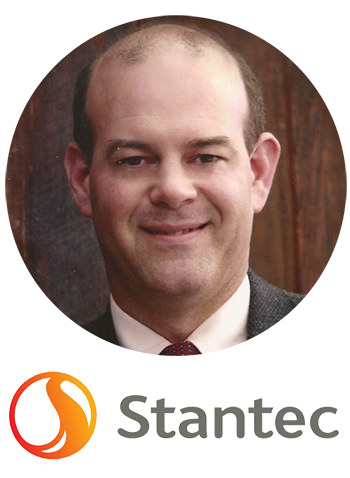 Ask Mario Sternad, Senior Engineer with Stantec Consulting Services, Inc., a global environmental services company and valued Land Science® client, what he enjoys most about his work and it will quickly become apparent that he draws immense satisfaction from providing effective and energy efficient solutions to address contaminants in our ever-changing environment. He shares, “Suffice to say, I love the technical and chemical aspects of my work. In-situ technologies has always been something of great interest to me- how soil, soil-vapor and groundwater contaminants move, are treated, and managed in the ground. Plus, the fact that there are always new products being developed that can make our lives simpler, make systems more reliable, and provide energy efficient ways to control chemicals in our environment is also exciting.” A 36-year veteran in engineering and environmental sciences, Sternad joined Stantec 17 years ago, first as a Safety Manager, and then as Project Manager, prior to being promoted to his current position. In his current role, he serves as a Remediation Subject Matter Expert in the Environmental Services Division of Stantec’s Walnut Creek, CA office. His day-to-day responsibilities include in-situ cleanup technologies for soil vapor, soil, and groundwater, as well as vapor intrusion and vapor barrier design. He continues, “More specifically, I prepare RIFS, RAPs and WPs for soil and groundwater remediation of VOCs, chlorinated solvents, hydrocarbons, petroleum, metals, and pesticides.” In addition, Sternad acts as a Stantec design lead and advisor during field work and construction, system and process development, equipment design, and other project related matters.
Ask Mario Sternad, Senior Engineer with Stantec Consulting Services, Inc., a global environmental services company and valued Land Science® client, what he enjoys most about his work and it will quickly become apparent that he draws immense satisfaction from providing effective and energy efficient solutions to address contaminants in our ever-changing environment. He shares, “Suffice to say, I love the technical and chemical aspects of my work. In-situ technologies has always been something of great interest to me- how soil, soil-vapor and groundwater contaminants move, are treated, and managed in the ground. Plus, the fact that there are always new products being developed that can make our lives simpler, make systems more reliable, and provide energy efficient ways to control chemicals in our environment is also exciting.” A 36-year veteran in engineering and environmental sciences, Sternad joined Stantec 17 years ago, first as a Safety Manager, and then as Project Manager, prior to being promoted to his current position. In his current role, he serves as a Remediation Subject Matter Expert in the Environmental Services Division of Stantec’s Walnut Creek, CA office. His day-to-day responsibilities include in-situ cleanup technologies for soil vapor, soil, and groundwater, as well as vapor intrusion and vapor barrier design. He continues, “More specifically, I prepare RIFS, RAPs and WPs for soil and groundwater remediation of VOCs, chlorinated solvents, hydrocarbons, petroleum, metals, and pesticides.” In addition, Sternad acts as a Stantec design lead and advisor during field work and construction, system and process development, equipment design, and other project related matters.
Throughout his career Sternad has worked on a variety of projects which include various refineries, coastline and beach cleanups, landfills, government sites, and a broad range of industrial sites. To prepare for a career in environmental sciences, he earned his BS in Chemical Engineering from the University of California Berkeley, and followed that with a CA CHE Professional Engineer Certification, and then a CA Civil Engineering Certification. He adds, “I have also been an active AIChE NorCal Section Member/Director since 1984.” When asked how he chose a career in environmental remediation, he says the technical aspects are what initially attracted him. He shares, “I was looking for an atmosphere of technical expertise to further my engineering knowledge. In environmental consulting, I liked the idea of multiple disciplines involved in soil and groundwater cleanup technologies, along with the unique, difficult, and complex solutions being used, and the need for chemical engineering expertise in the design, application, and equipment operation.”
With regard to working with Land Science, Sternad feels the company’s products, commitment to service, and knowledge base help set them apart. He continues, “Land Science has been, and continues to be, a dependable partner, offering outstanding products and expert engineering expertise, solutions, documentation, flexibility, and accurate and comprehensive procedures for installation of vapor barriers. We recently prepared a vapor barrier for a large office warehouse that required a unique solution to add and compact four feet of soil over the top of the vapor barrier in an expedited manner. This required using large scrapers, rollers, and bottom dumps, and resulted in faster application and easier vapor barrier installation below future building utilities, as well as added protection from volatiles in shallow groundwater. We successfully tested a small area first with Land Science’s involvement to see if this would work without damaging the vapor barrier.” Sternad is currently designing solutions using TerraShield® and TerraVent® products as preferred vapor intrusion solutions. “These products offer reduced vapor permeation rates, flexibility with application thickness, ease of application and testing, and an enhanced warranty that meets our project requirements. I also appreciate that Land Science provides their technical expertise during the design, application and testing of TerraShield.”
Residing in the San Francisco Bay area with his wife of 27 years and two adult children, Sternad spends approximately 20% of his time traveling to various project sites. Outside of work, he enjoys playing the trombone, mountain climbing, and working on cars. He shares, “I’ve been playing trombone for some 50 years in local symphony orchestras, symphonic bands, marching bands, jazz bands, and small instrumental groups. I currently play with various big bands in the Bay Area. In college, with the UC Berkeley Jazz Ensembles, I traveled in a big band touring group and recorded in Europe and Japan.” His climbing exploits include a month-long trek through Nepal in 2008 to the Khumbu glacier area, which included Mt. Everest base camp. “My brother and I have climbed various 14,000 ft. peaks in the Eastern Sierra, along with Mt. Whitney, and last year we climbed Mt. Shasta.” In addition, he finds time to stay involved with the Boy Scouts, teaching science-related merit badges.
When asked how he’s seen the industry evolve through the years, Sternad points to what he sees is a decrease in vapor intrusion regulatory levels. “The need to address vapor intrusion impacts has increased as regulatory levels have decreased,” he says. “This is both on the vapor extraction and vapor barrier sides. It has helped that the market has provided new, improved, and cost-effective technologies as the need increased. In addition, environmental assessment tools have changed (soil vapor and indoor air sampling), and remediation electrical controls have improved with higher accuracy.”
And how would he encourage others to join his field of study? He concludes, “It is amazing to be working in the environmental field at this time. I would suggest to new and young engineers, as well as scientists, that they try to see the larger picture- see how an individual project works as a whole. Be aware of the politics, the history of the project and how it started, and try to learn from anyone they can meet, whether it’s in contracts-administration, field staff, equipment vendors, or laboratories. They can all provide valuable insight into how systems work as a whole.”
Land Science is proud to have Mario Sternad, Senior Engineer with Stantec Consulting Services, Inc., as a valued client and partner in environmental remediation, and appreciates his diverse background and approach in providing successful remediation and mitigation outcomes for Land Science and its clients.
Client Spotlight: Paul French, Envirologic Technologies, Inc.
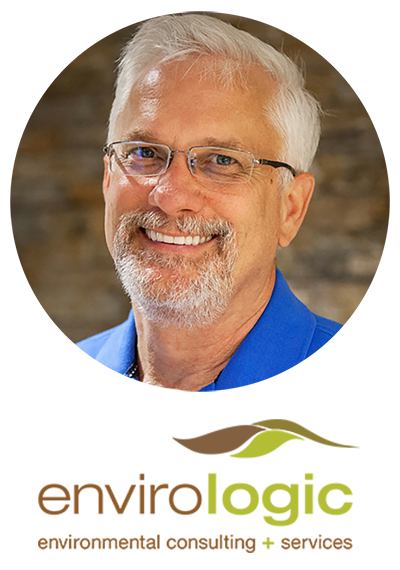 With a career in environmental mitigation that spans nearly 35 years, Paul French, Senior Project Manager/Hydrogeologist with Envirologic Technologies, Inc., a full service environmental consulting and services firm and valued Land Science® client, has seen first-hand how the industry has evolved from an emphasis on groundwater and cleanup to a vapor intrusion focus. He begins, “When I started in this industry, the primary focus was groundwater and cleanup to specific criteria. However, with the advent of the Risk Based Corrective Action process in 1994, the site investigations and closure fittingly moved toward elimination of an exposure pathway. Since most exposure pathways can be eliminated with institutional and/or engineering controls, vapor intrusion has become the primary driving factor for a good portion of our work.” As one might expect, French has also experienced how evolving technology continues to impact the industry. He continues, “The changes in technology have been immense. Computers were rare in my early years, and report were done by hand and submitted to clerical staff to decipher. Today, reports and communications are submitted digitally instead of printed and mailed. Information searches that used to take weeks to receive can now be completed and reviewed in a matter of minutes, and remote data recording and wireless transmission are now becoming the mainstay for monitoring of mitigation systems.” As a 28-year veteran with Envirologic, French finds himself utilizing much of today’s evolving technology as he fulfills a role as the company’s in-house specialist for vapor intrusion, which includes responsibilities involving the design, installation, and operation of vapor mitigation systems for Envirologic and its clients.
With a career in environmental mitigation that spans nearly 35 years, Paul French, Senior Project Manager/Hydrogeologist with Envirologic Technologies, Inc., a full service environmental consulting and services firm and valued Land Science® client, has seen first-hand how the industry has evolved from an emphasis on groundwater and cleanup to a vapor intrusion focus. He begins, “When I started in this industry, the primary focus was groundwater and cleanup to specific criteria. However, with the advent of the Risk Based Corrective Action process in 1994, the site investigations and closure fittingly moved toward elimination of an exposure pathway. Since most exposure pathways can be eliminated with institutional and/or engineering controls, vapor intrusion has become the primary driving factor for a good portion of our work.” As one might expect, French has also experienced how evolving technology continues to impact the industry. He continues, “The changes in technology have been immense. Computers were rare in my early years, and report were done by hand and submitted to clerical staff to decipher. Today, reports and communications are submitted digitally instead of printed and mailed. Information searches that used to take weeks to receive can now be completed and reviewed in a matter of minutes, and remote data recording and wireless transmission are now becoming the mainstay for monitoring of mitigation systems.” As a 28-year veteran with Envirologic, French finds himself utilizing much of today’s evolving technology as he fulfills a role as the company’s in-house specialist for vapor intrusion, which includes responsibilities involving the design, installation, and operation of vapor mitigation systems for Envirologic and its clients.
French joined Envirologic as a Project Manager/Hydrogeologist, prior to his promotion to his current position. In addition to his vapor intrusion responsibilities, he oversees all aspects of remedial investigations and cleanup at underground storage tanks and industrial and brownfield sites, while also serving as client, local, state, and federal regulatory agency liaison. Additionally, he manages proposal and work plan preparation, coordination of field staff and subcontractors, data assessment, reporting, budget tracking, and coordination of funding programs. In addition, his experience includes design, construction, operation, and maintenance of remedial systems, including groundwater pump and treat, NAPL recovery, soil vapor extraction, sub-slab vapor mitigation, and enhanced bioremediation. Although he has a vast and diverse range of responsibilities, more than anything it’s the hands-on approach to his work that he enjoys most. He continues, “In my current role I really enjoy the freedom to break away from office duties periodically to actually build the remedial systems that I design.”
To prepare for a career in environmental mitigation, French earned his BS in Geology from Murray State University, in his home state of Kentucky, and has since taken graduate level courses in Hydrogeology from Western Michigan University. To stay abreast of evolving trends and the latest technology in vapor intrusion, he regularly attends workshops, webinars, and regional training events. His expertise, culled through 3+ decades, no doubt helps in his efforts to achieve Envirologic’s goals, as outlined recently by CEO/Co-owner Jeff Hawkins. French continues, “While filming our recent 30th Anniversary video, Mr. Hawkins stressed that Envirologic has always been a boutique firm, rather than a subset of another company or another core business. He stated that this is our core business: environmental consulting. He and our leadership envision over the next five to ten years that we are likely to remain a consistent, nimble, customer-oriented company with some modest growth, adding team members who fit well with our organization and who can provide the integrity and level of service that we are known for. He closed by saying while growth is important, it is not our intent to ‘conquer the world’ with respect to the work that we do.”
When it comes to working with Land Science, French appreciates the company’s expertise and product knowledge. He shares, “Everyone I have dealt with at Land Science has an excellent working knowledge of their products and great insight on how their products can be best applied to my given issue. I appreciate that Land Science has always been willing to defend their products and our remedial goals with our state’s regulatory bodies.” With regard to using specific Land Science products and solutions for vapor mitigation barriers and venting systems, TerraShield®, Retro-Coat™, and TerraVent™ are often used with significant success. Residing in Kalamazoo, MI, He continues, “My projects have taken me throughout nearly all of lower Michigan. I have also spent a considerable amount of time in the Marquette, Houghton, and Calumet areas in Michigan’s Upper Peninsula.” Outside of work, he enjoys household remodeling projects and yardwork, “which helps to keep my wife happy — and me healthy.” He continues, “Keeping her projects up to date helps me to bank time for my real hobby of the last few years- motorcycling.” He also finds time to remain an active member and officer in an organization at his church that raises money for numerous causes, and for several years he has volunteered to provide a monthly meal and friendship at a home for recently released state prisoners.
When asked about the most challenging aspect of his work, he is quick to emphasize the impact of prioritization. “We all experience clients needing their projects completed ‘yesterday.’ Thus, there never seems to be enough time in a day to manage the current workload and address new projects and deadlines. It’s probably a combination of both, but if my white hair wasn’t hereditary, I’d blame it on my job.” He also feels it is a constant challenge to navigate inconsistency within various regulatory agencies and keep a project on schedule. He continues, “It is understood vapor intrusion pathway understanding is evolving, and to its credit, our state has come a long way in recent years in specifying how to evaluate the pathway. Currently however, there is no consistent process in the review of design specifications for a mitigation system or for performance monitoring. While Envirologic is competent in the design and installation of mitigation systems and conducting performance monitoring in accordance with industry standards, the inconsistency comes to light when state review and approval of a design, performance monitoring plan, or other document is necessary to satisfy the requirements of a financial institution or brownfield authority. The inconsistency typically results in the desire for additional data and/or multiple redesigns and nearly always results in the delay of a development, and in Michigan, for the most part, a delay means next year.” And how would French encourage others to join in his field of study? He concludes, “I would encourage others to develop an appreciation of science, since many of those disciplines can be adapted to this industry. I would also encourage anyone who wants to get ahead in this field, or any field for that matter, to become comfortable speaking in public. Overcoming that fear will bring about opportunities.”
Land Science is proud to have Paul French, Senior Project Manager/Hydrogeologist with Envirologic Technologies, Inc., as a valued client and partner, and appreciates his diverse background and thorough approach in providing successful vapor intrusion mitigation outcomes for Land Science and its clients.
TerraShield Protects Future Occupants from Harmful Vapor Intrusion
Case study highlights:
- TerraShield was considered the safest and most effective choice to protect against the high levels of vapor contaminants found onsite
- The installation of TerraShield eliminated potential health risks for future onsite employees posed by the hazardous vapor intrusion exposure from the TCE and PAH contaminants
- TerraVent, a low-profile trenchless vapor collection system, was installed on this site
A large automotive and supply company planned to build its new corporate headquarters on a 4.5-acre brownfield site recently acquired in Southfield, MI. Soil and groundwater sampling on the property revealed the presence of trichloroethylene (TCE) and polynuclear aromatic hydrocarbons (PAHs). TCE was also identified in soil gas beneath the site. Within the footprint of the planned building itself, contaminant concentrations were found to be in excess of applicable indoor air quality screening levels. The developer utilized brownfield funding from the local authority to conduct the necessary environmental remediation measures.
Nitra-Seal Ensures Long Term Vapor Intrusion Protection for Quick Service Restaurant
Case study highlights:
- Quick service retail restaurant required an effective preemptive vapor mitigation solution to protect future employees and customers from potential vapor intrusion risks
- The project development team determined Nitra-Seal was the safest, most expedient and cost-effective vapor barrier system to install on this site
- Land Science Certified Applicator S&H Waterproofing and Construction, installed Nitra-Seal and performed smoke testing as part of the quality control process to confirm proper installation of the barrier
This project development site is a newly opened quick-service restaurant in Conyers, Georgia. Offsite chemical spills from historical operations had resulted in low-level volatile organic compounds (VOCs) released to the subsurface, creating a potential for vapors to intrude into new buildings constructed in the affected area. Recognizing the risk and placing emphasis on future workers’ safety, the forward-thinking client decided that a preemptive measure be instituted, requiring the installation of a vapor mitigation system as part of the construction specification.
Client Spotlight: Torin R. Snyder, Principal at Rincon Consultants
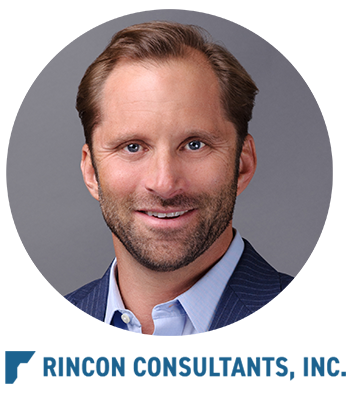 When Torin Snyder isn’t swimming or being dance-dad extraordinaire, he can be found pursuing another lifelong passion – finding effective, creative solutions to complex environmental issues. Snyder is a principal at Rincon Consultants, Inc., a leading California-based environmental consulting firm and valued Land Science client. His career path was no surprise to him, as Snyder recalls his interest in the environmental sciences blossoming during his university days. When he began to explore the field as a potential career path, he soon realized environmental site assessment and mitigation would provide the ideal avenue to satisfy his curiosity.
When Torin Snyder isn’t swimming or being dance-dad extraordinaire, he can be found pursuing another lifelong passion – finding effective, creative solutions to complex environmental issues. Snyder is a principal at Rincon Consultants, Inc., a leading California-based environmental consulting firm and valued Land Science client. His career path was no surprise to him, as Snyder recalls his interest in the environmental sciences blossoming during his university days. When he began to explore the field as a potential career path, he soon realized environmental site assessment and mitigation would provide the ideal avenue to satisfy his curiosity.
“I have always been fascinated in environmental sciences, but I found early on, and still find, that environmental mitigation is especially interesting because it is always evolving with emerging chemicals, new clean-up goals, and new technologies,” Snyder says of the field. “This industry offers an opportunity to introduce innovative options to clients, enabling them to achieve their overall project goals and expectations, and it lets me learn and think outside the box.” Snyder joined Rincon in 2010 as a senior hydrogeologist and was promoted to principal in 2018. Prior to joining Rincon, he served as a project manager in the hydrogeology department for an environmental planning company.
To prepare for his career in environmental mitigation, in 1999 Snyder earned his BS in Soil Science, with a Hydrology concentration, from California Polytechnic State University, in San Luis Obispo. “After-graduation, I focused on getting the certifications and licenses relevant to the environmental consulting industry. First, I became a Certified Professional Soil Scientist, then a Registered Environmental Assessor, then a Deputy Methane Building Inspector for the City of Los Angeles Department of Building and Safety. Later, I became a Professional Geologist, Qualified SWPPP Developer/Practitioner, Certified Hydrogeologist, and finally a Trainer of Record for the Qualified SWPPP Developer/Practitioner program. Sometimes people tease me for having so many initials behind my name.”
As a Principal for Rincon’s statewide Environmental Site Assessment and Remediation practice, Snyder is responsible for business development, client management, technical and quality control, and staff mentoring and development. He says of his many roles at the firm, “I provide leadership for the Environmental Site Assessment and Remediation group, and I support the Environmental Sciences and Land Use Planning group and Natural and Cultural Resource team at Rincon. The diverse clients and projects keep me engaged, while giving me new challenges to meet, which I enjoy very much.”
To stay abreast of new technologies and emerging trends, Snyder keeps up with seminars, conferences, and training programs for the field. “Our industry is always evolving,” he says. “So, education and training are critical to remain current with new solutions our clients expect and deserve. It seems there’s always a new or better way to complete a project.” With his diverse background, responsibilities and commitment to staying current in the industry, Snyder does his part to help Rincon achieve its long-term goal of “offering clients the best services, best products, and best people in our field.”
When it comes to working with Land Science, Snyder appreciates the company’s wide range of technologies. “Land Science has done a good job providing alternative products to solve vapor intrusion challenges. There are many solutions available, but few are as effective as those Land Science offers.” He goes on to say that “finding a product that is cost-competitive and that protects the occupants of the building is the most important consideration. Land Science offers multiple products for different applications, which is critical. For example, our clients like the protection that MonoShield™ offers for low-risk vapor intrusion sites and they appreciate that the product is cost-effective compared to most other vapor barriers.” Recently, Snyder has recommended MonoShield™ for a number of projects Rincon has tackled that included low-risk vapor intrusion concerns for low-income housing projects.
Residing in Carlsbad, California with his wife and two daughters, Snyder works out of the Rincon office there. In his free time, he enjoys the outdoors, with mountain biking, open-water swimming, and off-road triathlons (Xterra) topping his list of favorite activities. He likes them so much he participates in mountain bike and open water swim racing. “I’m a fairly competitive guy so I love to sign up for races,” he shares. “One of my favorite race experiences was when I competed in the Xterra Off-Road World Championship in Maui in 2018.” He also finds time to volunteer as an Advisory Council Member for the Natural Resource and Environmental Sciences Department at California Polytechnic State University, San Luis Obispo.
When asked what he enjoys most about his job, he points to the collaborative nature of working with co-workers and clients. “I also take satisfaction in providing a client an out-of-the- box solution for their specific problem.” And the most demanding aspect of his job? “Right now, the COVID-19 pandemic. This has changed our day to day routine and requires us to be nimble and adaptive to the new norm.” He also feels the trend of emerging chemicals, evolving clean-up goals, and discovering new solutions to help solve remedial challenges is here to stay- at least for some time. He continues, “As regulations become tighter, consultants will be forced to reconsider how a project is scoped and completed. For example, as clean up goals become more conservative, it may not be economically feasible to remediate a site the same way we did 10 years ago. Therefore, interim mitigation measures, like vapor barriers, sealing concrete floors, and HVAC modifications, need to be considered to reduce the time a building may sit unoccupied during remedial activities when there are indoor air concerns.”
And how would he encourage others to join his field of study? He concludes, “I would not necessarily use the word “encourage.” Finding your passion is the most important aspect to a rewarding, challenging, and successful career. So, I feel it’s critical for people who might be interested in this field to first understand their own passion- what makes them tick. Once this is understood, the path to a fulfilling and successful career path can be tailored to an individual.”
Land Science is proud to have Torin Snyder, Principal at Rincon Consultants, Inc., as a valued client and partner, and appreciates his highly diverse background and approach in providing successful vapor intrusion mitigation outcomes for Land Science and its clients.
Nitra-Seal Specified to Mitigate VOCs for Urban Atlanta Townhome Development
A leading national builder of luxury homes recently acquired a brownfield site in Midtown Atlanta with plans to develop a large-scale multi-phase townhome project. The developer planned to construct nine individual buildings on the site, each ranging from 4,000 to 6,000 square feet, with multiple townhouse units inside. Slab-on-grade foundations were set, but construction could not continue without understanding each building’s vapor intrusion risks and creating a plan to provide reliable protection for future residents.
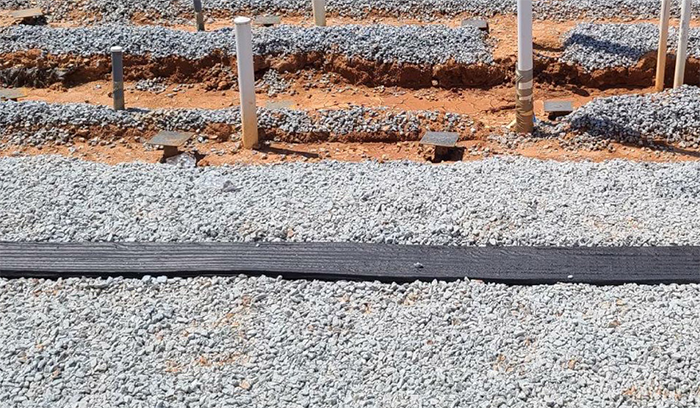
This case study features the following:
- Nitra-Seal protects future residents of new urban townhomes
- Total Vapor Solutions selected Nitra-Seal and TerraVent for this site after soil and gas samples revealed the need for a vapor intrusion mitigation system.
- It was determined that Nitra-Seal should be laid across every foundation, but ventilation needs were not uniform for all the buildings.



